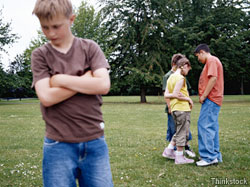(ARA) – Bullying is a headline-grabbing issue these days, one many adults know of first-hand from their own childhood experiences. Fortunately, bullying — once considered a normal and unavoidable part of the schoolyard landscape — is now viewed as a much more serious matter.
Parents of children with an autism spectrum disorder (ASD) may be especially worried about the issue of bullying, fearing their child’s characteristic social deficits make him or her a particularly tempting target.
Kennedy Krieger Institute’s Interactive Autism Network (IAN), the largest online autism research effort in the world, recently released a report exploring how children with ASD are particularly at risk of becoming victims of bullying. Children with ASD may have trouble correctly interpreting social cues, especially in a bullying situation where the bully may intentionally mislead the child.
It is not hard for parents of children on the autism spectrum to imagine the scenarios: their child’s inability to “read” the social signs that someone doesn’t have her best interest at heart; the eagerness to please that can make him easy to manipulate; the tendency to say what he thinks without a full understanding of consequences. Many children who are bullied do not report it to parents or other adults. In addition to this general tendency not to tell, children with ASD may be nonverbal, and so unable to communicate that they are being bullied, or they may have fluent language skills, but be unable to interpret the situation. Many times, children with ASD also may have trouble distinguishing bullying from good-natured teasing. When all parties are having fun, it’s not bullying, a concept that may be difficult for a child with ASD to grasp.
In some cases, children with ASD can also become what is known as a “bully-victim.” As other children learn to trigger a child’s meltdown, he or she can be provoked into behavior that results in punishment while the “real” bullies go unnoticed.
Successful anti-bullying strategies require a team effort from school personnel, early childhood professionals and psychologists, students involved in bullying as targets or aggressors, and child bystanders. Teachers and other staff should be trained on how to respond to bullying, while victims and bullies need training in special social skills that target the perceptions, misinterpretations or interactions that contributed to the bullying in the first place.
Making a child less isolated is one crucial piece of this puzzle, perhaps via inclusion in an ongoing support or social skills group, perhaps with other children with ASD. Even child bystanders can be provided with a safe way to report bullying incidents so they can do the right thing without fearing they will make themselves a bully’s next target.
What if efforts made by parents, in partnership with a school, fail? What might a parent do? Suggestions include:
* Find out exactly what the school’s anti-bullying policy (if any) contains.
* Determine if the school is implementing that policy effectively, or at all. Has a lack of tolerance for bullying really been incorporated into the school’s culture? Or is the school only paying lip service to a zero tolerance for bullying?
* If the policy is not being implemented in an effective way, make an issue of the fact that your child is not able to benefit from his or her education when he or she is being bullied and living in fear.
* Don’t accept “We didn’t see it happen” and “It’s that kid’s word against his” as excuses for inaction, especially if the conditions remain the same and the same things happen again. If incidents are occurring at the same place and time (during gym, on the playground at recess, in the cafeteria), someone should be assigned to monitor and “catch” the next incident in progress.
* Expand their thinking. Are they really grasping how a child’s ASD is playing into a bullying situation, whether the child is a victim or a bully-victim? Are the interventions proposed getting at the real issues, or are old myths and ways of thinking about bullying coloring adult responses?
* If a child does act out such that he or she would usually be suspended or face other drastic action, does the school hold the required Individualized Education Plan meeting to determine whether the behavior was a manifestation of the child’s disability?
Parents, teachers, and school staff can play a proactive role by understanding the danger and intervening the moment there is a problem.
To learn more about the IAN Project and to reference the full report, visit: www.ianproject.org.

